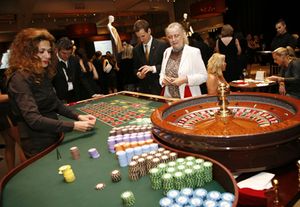The roots of lotteries go down deep and spread far. "Casting lots" is even mentioned in the Bible. The first lottery to offer cash prizes probably originated in Florence, Italy, in the 16th century. It was dubbed Lotto de Firenze, and it quickly spread to other Italian cities. The game, as well as the name, caught on. Italy's national lottery is still called Lotto, as are those in the U.S. and many other countries.
During Colonial times, lotteries were all the rage in America. Most were held for charitable or civic purposes, such as building churches, bridges, and schools. But lotteries fell into disfavor by the mid-19th century. Things changed in the second half of the 20th century. New Hampshire was the forerunner, holding its first lottery in 1964. Other states gradually followed suit. In the '80s and particularly the '90s, the ancient game became hotter than a two-dollar pistol.
You'll see people of all ages and from all walks of life picking and scratching (picking numbers and scratching off instant tickets, that is). In the United States, total annual lottery sales have grown into the billions of dollars. In many states, all it costs to take a chance on changing your life forever is $1. Where else can you buy a dream for a dollar?
Remember, no person, system, or article can truthfully guarantee to make you a lottery winner. What this article provides is a brief overview of the different games and how they're played. It gives you a slew of ideas and tips on what to do and what to avoid. There's even advice on what to do if you win. For the most part, it presents a host of number-picking strategies to help you overcome those long odds.
So choose a system, have some fun, and take a chance. You just might end up a millionaire.
During Colonial times, lotteries were all the rage in America. Most were held for charitable or civic purposes, such as building churches, bridges, and schools. But lotteries fell into disfavor by the mid-19th century. Things changed in the second half of the 20th century. New Hampshire was the forerunner, holding its first lottery in 1964. Other states gradually followed suit. In the '80s and particularly the '90s, the ancient game became hotter than a two-dollar pistol.
You'll see people of all ages and from all walks of life picking and scratching (picking numbers and scratching off instant tickets, that is). In the United States, total annual lottery sales have grown into the billions of dollars. In many states, all it costs to take a chance on changing your life forever is $1. Where else can you buy a dream for a dollar?
Remember, no person, system, or article can truthfully guarantee to make you a lottery winner. What this article provides is a brief overview of the different games and how they're played. It gives you a slew of ideas and tips on what to do and what to avoid. There's even advice on what to do if you win. For the most part, it presents a host of number-picking strategies to help you overcome those long odds.
So choose a system, have some fun, and take a chance. You just might end up a millionaire.
Advertisement











